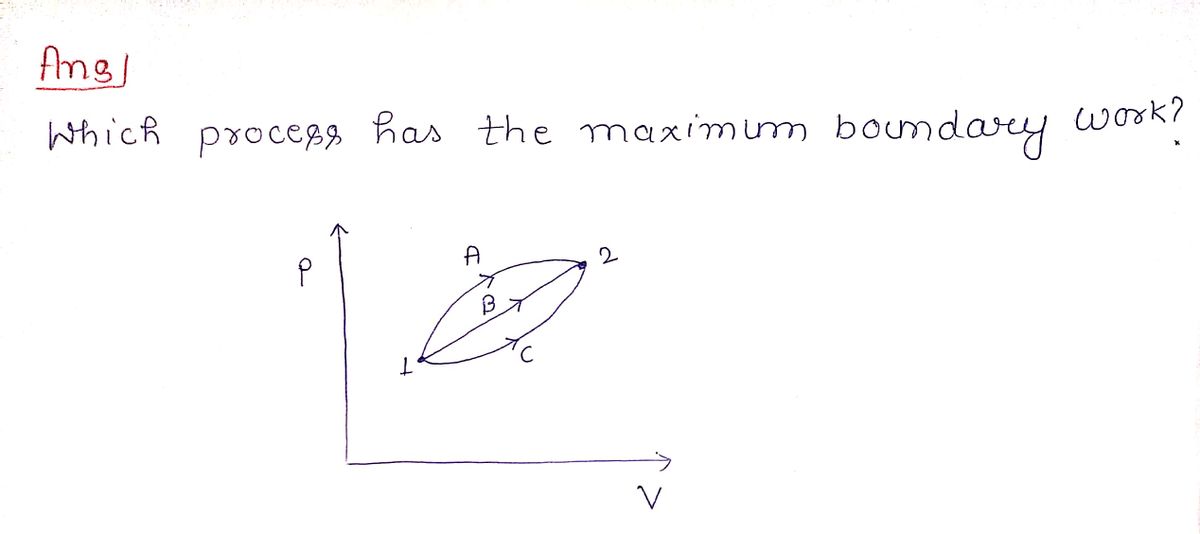Shown below is the P-V plot for three processes A, B, and C from state 1 to state 2. Which process has the maximum boundary work W₁?_ O A.A B. B Oc.c A B
Shown below is the P-V plot for three processes A, B, and C from state 1 to state 2. Which process has the maximum boundary work W₁?_ O A.A B. B Oc.c A B
Elements Of Electromagnetics
7th Edition
ISBN:9780190698614
Author:Sadiku, Matthew N. O.
Publisher:Sadiku, Matthew N. O.
ChapterMA: Math Assessment
Section: Chapter Questions
Problem 1.1MA
Related questions
Question
shown below is the P-V plot for three processes A, B, and C from state 1 to state 2. Which process has the maximum boundary work Wb?_________
| A. |
A |
|
| B. |
B |
|
| C. |
C |

Transcribed Image Text:**PV Plot Analysis for Boundary Work**
The diagram above depicts a Pressure-Volume (PV) plot for three processes labeled A, B, and C, transitioning from state 1 to state 2. The main objective is to determine which process results in the maximum boundary work, denoted as \( W_b \).
**Graph Description:**
- The plot is a graph with Pressure (P) on the vertical axis and Volume (V) on the horizontal axis.
- The transition from state 1 to state 2 is represented by three distinct curves:
- Process A follows a concave trajectory above processes B and C.
- Process B transitions with a slightly straighter curve below process A, positioned in the middle.
- Process C is the lowest curve, more linear compared to A and B, below both.
**Question:**
Which process has the maximum boundary work \( W_b \)?
- A. A
- B. B
- C. C
**Note:** The area under each curve in a PV plot represents the boundary work done by the system. The process with the largest enclosed area between the curve and the volume axis from state 1 to state 2 will have the maximum boundary work.
Expert Solution
Step 1

Step by step
Solved in 2 steps with 2 images

Knowledge Booster
Learn more about
Need a deep-dive on the concept behind this application? Look no further. Learn more about this topic, mechanical-engineering and related others by exploring similar questions and additional content below.Recommended textbooks for you

Elements Of Electromagnetics
Mechanical Engineering
ISBN:
9780190698614
Author:
Sadiku, Matthew N. O.
Publisher:
Oxford University Press

Mechanics of Materials (10th Edition)
Mechanical Engineering
ISBN:
9780134319650
Author:
Russell C. Hibbeler
Publisher:
PEARSON

Thermodynamics: An Engineering Approach
Mechanical Engineering
ISBN:
9781259822674
Author:
Yunus A. Cengel Dr., Michael A. Boles
Publisher:
McGraw-Hill Education

Elements Of Electromagnetics
Mechanical Engineering
ISBN:
9780190698614
Author:
Sadiku, Matthew N. O.
Publisher:
Oxford University Press

Mechanics of Materials (10th Edition)
Mechanical Engineering
ISBN:
9780134319650
Author:
Russell C. Hibbeler
Publisher:
PEARSON

Thermodynamics: An Engineering Approach
Mechanical Engineering
ISBN:
9781259822674
Author:
Yunus A. Cengel Dr., Michael A. Boles
Publisher:
McGraw-Hill Education

Control Systems Engineering
Mechanical Engineering
ISBN:
9781118170519
Author:
Norman S. Nise
Publisher:
WILEY

Mechanics of Materials (MindTap Course List)
Mechanical Engineering
ISBN:
9781337093347
Author:
Barry J. Goodno, James M. Gere
Publisher:
Cengage Learning

Engineering Mechanics: Statics
Mechanical Engineering
ISBN:
9781118807330
Author:
James L. Meriam, L. G. Kraige, J. N. Bolton
Publisher:
WILEY